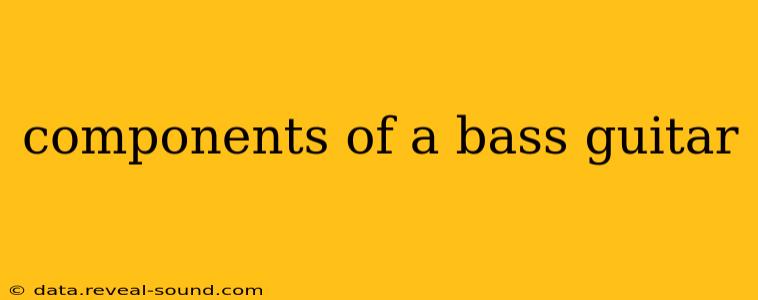The bass guitar, the rhythmic heartbeat of countless musical genres, is more than just strings and wood. Understanding its individual components is key to appreciating its sound, playability, and overall construction. This comprehensive guide will explore each part, answering common questions and offering insights for players of all levels.
What are the main parts of a bass guitar?
The main components of a bass guitar can be broadly categorized into the body, neck, hardware, and electronics. Let's break down each section:
1. The Body: This is the resonant chamber of the bass, contributing significantly to its tone and sustain. Different woods, like alder, ash, mahogany, and basswood, offer varying tonal characteristics. The body's shape and size also influence comfort and playing style. Many basses feature a cutaway, allowing easier access to the higher frets.
2. The Neck: The neck is arguably as crucial as the body. It houses the fretboard, where the strings are pressed to produce different notes. The neck's material (maple, rosewood, etc.) and profile (the shape of its cross-section) directly impact playability and tone. The neck joint, where the neck meets the body, is also an important design element affecting tone and sustain.
3. The Hardware: This encompasses all the non-electronic components crucial for the bass's functionality. Key hardware elements include:
- Bridge: This holds the strings in place and transmits vibrations from the strings to the body. Different bridge designs (e.g., fixed, adjustable) influence intonation and sustain.
- Tuners (Machine Heads): These are responsible for tuning the strings to the correct pitch. High-quality tuners offer greater tuning stability.
- Nut: Located at the top of the fretboard, the nut guides the strings and affects their vibration.
- Strap Buttons: These secure the bass to a strap, allowing for comfortable playing while standing.
4. The Electronics (for most basses): Most electric basses feature pickups that convert string vibrations into electrical signals. These signals are then processed by the electronics, usually including:
- Pickups: These are the heart of the bass's sound. Different pickups (e.g., single-coil, humbucker) offer distinct tonal characteristics. Many basses feature multiple pickups allowing for tonal variety.
- Controls: These knobs usually adjust volume, tone, and potentially blend the output of multiple pickups. Active basses may have additional controls for boosting or shaping the signal.
What is the most important part of a bass guitar?
There's no single "most important" part. The bass guitar's sound and playability result from the interaction of all its components. A great neck on a poorly-constructed body will still be problematic, and vice versa. However, the neck's playability and the pickups' tonal characteristics are arguably the most directly influential elements for the player's experience.
How many parts are in a bass guitar?
The number of individual parts varies greatly depending on the bass model and complexity. However, the core components—body, neck, hardware, and electronics—remain constant. Counting every screw, nut, and bolt would yield a much higher number, but it's the major functional components we’re most concerned with.
What are the different types of bass guitars?
Bass guitars come in a wide array of styles and configurations, including:
- Precision Bass (P-Bass): Known for its warm, punchy tone and single-coil pickup.
- Jazz Bass (J-Bass): Characterized by its bright, articulate tone and two single-coil pickups.
- Fretless Bass: Lacks frets, offering a smooth, almost cello-like sound.
- Acoustic Bass: Uses a hollow or semi-hollow body for natural resonance.
Understanding the individual components of a bass guitar is essential for players seeking to optimize their instrument's sound, maintain its condition, and ultimately improve their playing. This breakdown serves as a starting point for a much deeper exploration of this incredible instrument.
